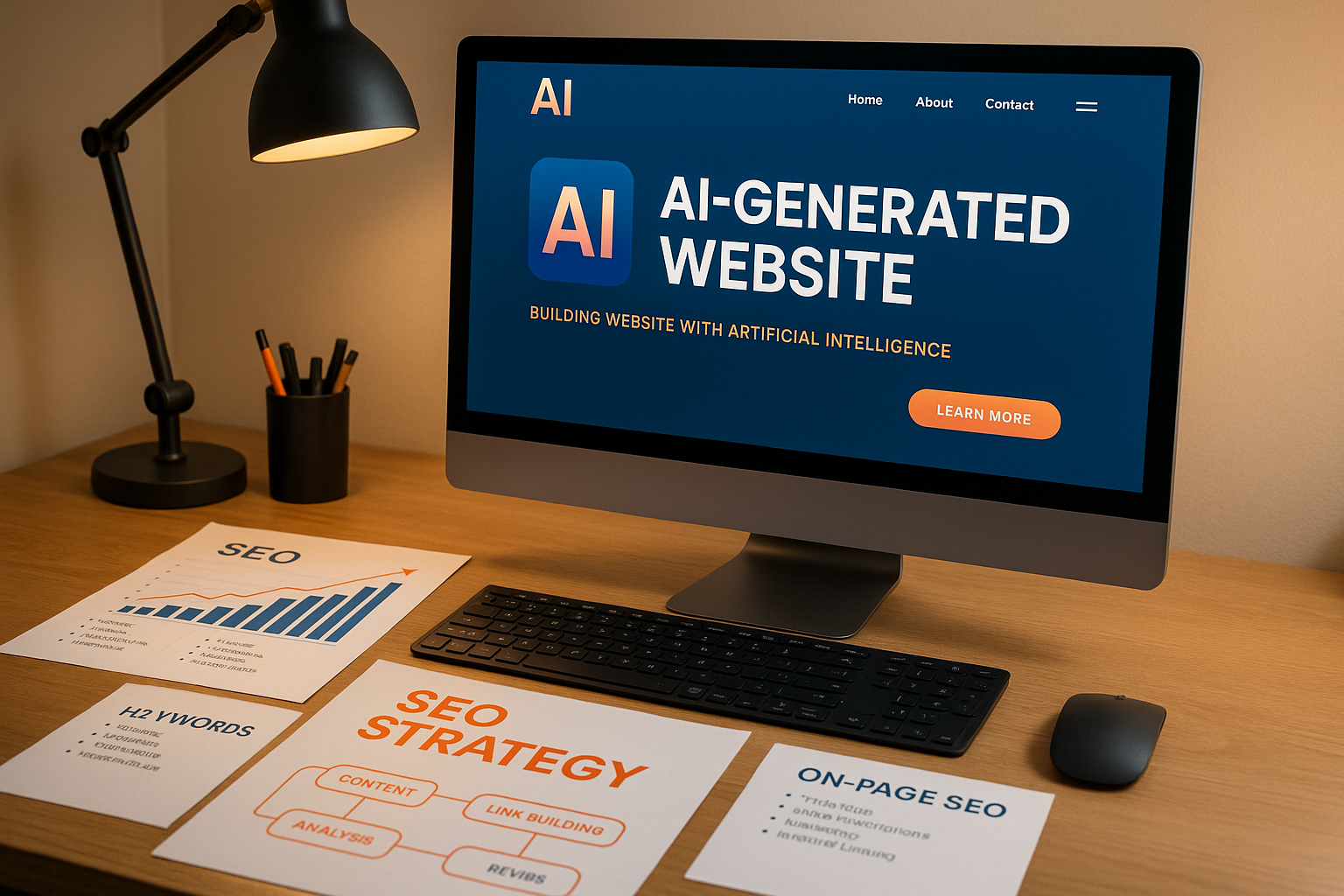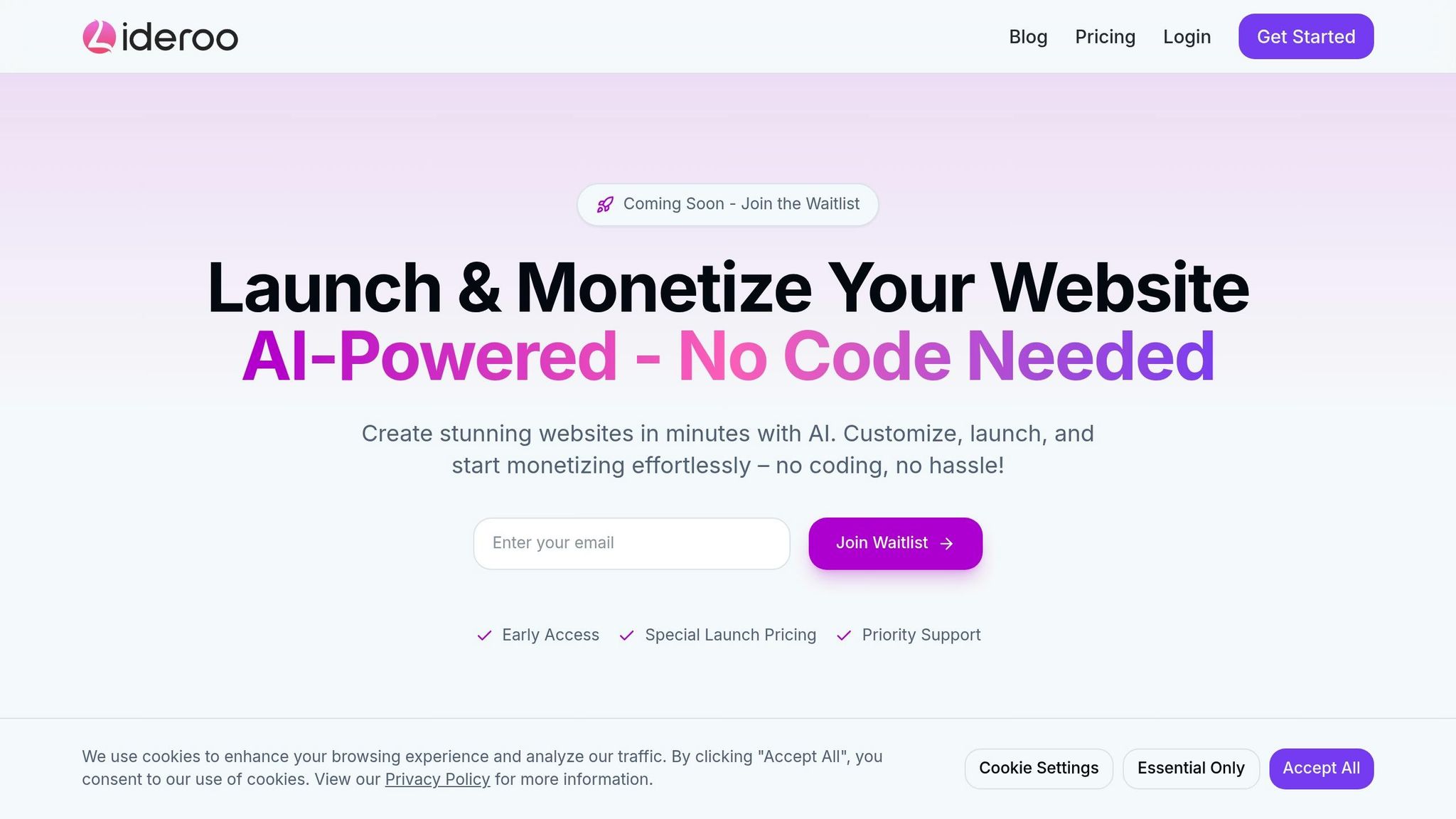SEO Strategy for AI-Generated Websites

AI-generated websites face unique SEO challenges, like indexing issues, duplicate content, and low authority signals. But with the right strategies, these sites can rank well and attract traffic. Here’s how to optimize AI-driven content for search engines:
- Focus on E-E-A-T: Ensure your content demonstrates Experience, Expertise, Authoritativeness, and Trustworthiness.
- Use AI for keyword research: Tools like Semrush and Claude 3.5 can uncover long-tail keywords and user intent.
- Avoid duplicate content: Edit AI-generated drafts for originality and use tools like Copyscape to check for plagiarism.
- Optimize technical SEO: Improve site structure, fix broken links, and use schema markup (e.g., FAQ, HowTo) to help search engines understand your content.
- Boost page speed: Compress images, use lazy loading, and leverage CDNs to meet Core Web Vitals standards.
Quick Comparison: Key SEO Focus Areas
| Area | Best Practices |
|---|---|
| Content Quality | Edit AI drafts, add unique insights, and align with user intent |
| Keyword Research | Use AI tools for long-tail keywords and intent analysis |
| Duplicate Content | Check originality with tools, use canonical tags, and update sitemaps regularly |
| Technical SEO | Optimize structure, add schema markup, and improve JavaScript rendering |
| Page Speed | Compress assets, use CDNs, and implement predictive preloading |
AI and SEO: Revolutionizing Search Strategies for 2024 and Beyond
How to Optimize AI-Generated Content for Search Engines
Getting AI-generated content to rank well requires precise optimization. As AI-generated summaries increasingly dominate search engine results pages (SERPs), tailoring content to meet user needs becomes essential.
The backbone of effective AI content optimization lies in the E-E-A-T principles - Experience, Expertise, Authoritativeness, and Trustworthiness. Search engines have become adept at identifying repetitive or shallow content that lacks real value. To stand out, your content must demonstrate expertise and provide unique perspectives, supported by accurate statistics, relevant context, and clear presentation.
Let’s dive into how AI tools can refine your keyword research and help you craft content that aligns with search engine optimization (SEO) standards.
Using AI Tools for Keyword Research
Traditional keyword research methods often miss subtle patterns in user searches. AI-powered tools, on the other hand, excel at analyzing vast datasets to uncover opportunities that manual methods might overlook.
For instance, Semrush’s Keyword Magic Tool uses AI to identify keyword clusters and suggest long-tail keywords tailored to user intent. Their AI Copilot feature takes it further by offering optimization strategies.
Joe Cinquegrani, Senior SEO Strategist at NP Digital, highlights the value of combining AI tools:
“Mindful prompting and introducing competitors for analysis will offer excellent new topic ideas that can then be vetted in a third-party tool, like Semrush. From there, I like to use Claude 3.5 to ideate content outlines, and often, it will present sub-topics that I never thought of before.”
The real strength of AI-driven keyword research lies in its ability to pinpoint long-tail keywords - terms that draw targeted traffic with less competition. These tools also adapt to search engine updates, ensuring your strategy remains current.
When leveraging AI for keyword research, focus on understanding the three primary search intents:
- Informational: Users seeking knowledge or answers.
- Transactional: Users ready to make a purchase or take action.
- Navigational: Users looking for a specific site, page, or resource.
By aligning your content with these intents, you can better meet searchers’ needs and improve your rankings.
Once you’ve nailed your keyword strategy, the next step is crafting content that satisfies user intent.
Creating Content That Matches User Intent
Search engines now prioritize content that addresses the context and intent behind user searches, not just content stuffed with keywords. This means your AI-generated content must answer users’ underlying questions clearly and directly.
To create content that performs well:
- Analyze top-ranking pages for your target keywords. Study the questions they answer, the formats they use, and areas where they fall short.
- Use clear headings and subheadings to organize information logically.
- Provide concise answers upfront, followed by a deeper dive into details.
Schema markup can also play a big role in helping search engines understand your content’s structure. Here’s a quick guide to schema types and their uses:
| Schema Type | Best For | AI Search Engine Usage |
|---|---|---|
| FAQPage | Question-based content | Provides concise answers in AI-generated results |
| HowTo | Step-by-step guides | Delivers structured instructions |
| Article | Long-form content | Summarizes and provides detailed insights |
Because AI-generated search results can fluctuate in real time, maintaining high-quality, regularly updated content is essential to staying visible.
With user-focused content in place, it’s also crucial to address duplicate content issues to protect your site’s rankings.
Avoiding Duplicate Content Issues
AI tools often produce similar responses to identical prompts, which can lead to duplicate content - a major red flag for search engines. Google penalizes duplicate content, even if it’s generated by AI.
“Google may not penalize AI content specifically, but it does penalize duplicate content, and AI tools are prone to creating very similar responses to the same question.” - 321 Web Marketing
To avoid this, every AI-generated piece should go through thorough editing to ensure originality and accuracy. Fact-checking and adding unique insights are critical steps in this process.
A great example comes from LinkedIn. In 2023, they used AI to draft initial articles on professional topics, then invited industry experts to expand and refine them. This collaboration led to over 140,000 AI-assisted articles, reaching more than 1.5 million organic users.
Here’s how you can prevent duplicate content issues:
- Use plagiarism checkers like Copyscape or Grammarly to spot unintentional duplication.
- Implement canonical tags, 301 redirects, and “no-index” tags to guide search engines toward preferred versions of your content.
- Conduct regular site audits to identify and resolve duplicate content.
- Submit updated sitemaps to search engines to clarify which pages should be indexed.
Ultimately, treat AI-generated content as a starting point, not the final product. By adding your unique perspective and expertise, you’ll create content that stands out and delivers real value to your audience.
Technical SEO for AI-Powered Websites
Building on content optimization strategies, technical SEO ensures AI-powered websites achieve full visibility. A solid technical setup is critical for AI crawlers to properly index your content. Unlike traditional search bots, AI crawlers operate differently, requiring specific adjustments to ensure your site gets the visibility it deserves.
Peter Rota, a leading SEO consultant, sheds light on the current challenges:
“AI crawlers’ technology is not as advanced as search engine bots crawlers yet. If you want to show up in AI chatbots/LLMs, it’s important that your JavaScript can be seen in the plain text (HTML source) of a page. Otherwise, your content may not be seen”.
This highlights the need for a strategic approach to the technical framework of AI-driven websites.
Improving Website Structure
A clear and logical website structure benefits both traditional search engines and AI crawlers. However, AI systems rely heavily on natural language processing (NLP) to understand context, making an organized site structure even more essential.
To guide AI crawlers effectively:
- Configure your robots.txt file and keep XML sitemaps updated. For AI-powered sites that generate dynamic content, automating sitemap updates is crucial.
- Strengthen internal linking. Use descriptive anchor text to establish a clear hierarchy with categories and subcategories. This helps AI systems understand content relationships and relevance.
- Fix broken links and redirect chains, as these can block crawlers from accessing key content.
- For websites relying heavily on JavaScript, implement dynamic rendering solutions. This approach delivers a static HTML version of pages to bots while maintaining an interactive experience for users.
Once your structure is optimized, enhance your site further with schema markup.
Schema Markup and Metadata Optimization
Schema markup provides structured data that helps AI systems understand the meaning and context of your content. Originally launched in 2011 through a collaboration between Google, Bing, Yahoo!, and Yandex, schema has become indispensable in the AI era.
Schema markup not only improves rankings but also aids AI agents in content discovery and integration with AI assistants. For example, Botify’s SmartContent tool, introduced in March 2025, enables teams to generate metadata for thousands of pages within minutes. It allows customization to align metadata with a company’s voice and strategy while optimizing it for search.
Key schema types for AI-powered sites include:
- Organization Markup for company details
- Product Markup for e-commerce listings
- FAQ Markup for question-based content
- Article Markup for blogs
- Event Markup for time-sensitive information
With schema in place, focus on improving page speed to ensure both users and AI crawlers have a seamless experience.
Page Load Speed and Core Web Vitals
Page speed is critical for user experience and search rankings, but AI-powered websites face unique challenges due to dynamic content and real-time processing.
A 1-second delay can reduce conversions by 7%, and as load times increase from 1 to 3 seconds, bounce rates jump by 32%. Fast load times are equally important for AI crawlers, ensuring they can process your content effectively.
| Metric | What It Measures | Ideal Value |
|---|---|---|
| LCP | Time for the largest element to load | ≤ 2.5 seconds |
| FID | Time to respond to user interaction | ≤ 100 ms |
| CLS | Visual stability during load | ≤ 0.1 |
| FCP | Time for the first content to appear | ≤ 1.8 seconds |
| TTFB | Time for server to respond | ≤ 800 ms |
AI-powered tools can quickly identify performance bottlenecks that traditional tools might overlook.
One standout technique is predictive preloading. Tools like Navigation AI analyze user behavior and preload pages before clicks, significantly reducing perceived load times.
Vasil Dachev, a Performance Engineer at Uxify, highlights the value of AI in performance optimization:
“AI bridges the gap between technical complexity and business goals, giving you faster load times, smoother navigation, and insights you can actually use”.
Several companies have seen measurable results from these strategies. Revelry improved load speeds by 43%, increasing conversions by 30%. eBay saw a 0.5% rise in “Add to Cart” actions for every 100ms of speed improvement. Vodafone boosted landing page speed by 31%, leading to an 8% uptick in sales.
For immediate results, focus on:
- Optimizing images with next-gen formats like WebP and AVIF
- Minifying and combining CSS, JavaScript, and HTML files
- Caching static assets at both the browser and server levels
- Using a Content Delivery Network (CDN) for global content distribution
- Asynchronous loading of JavaScript to prevent delays
- Lazy loading images and videos to reduce initial load times
AI-powered Real User Monitoring (RUM) tools can track these optimizations in real-time, flagging issues before they affect users. These tools make performance insights accessible to both technical and non-technical teams, ensuring smooth operations.
Common SEO Challenges for AI-Generated Websites
AI-powered websites bring a world of efficiency to content creation, but they also come with their own set of SEO hurdles. These challenges often differ from those faced by traditional sites, making it essential to address them head-on to maintain strong search visibility.
Dynamic Content and Indexing
One recurring issue with AI-generated content is its struggle to get properly indexed, which can significantly limit visibility. In August 2024, Prerender.io highlighted that AI-generated content often experiences delays in indexing. This affects both fully AI-generated content and content created with AI assistance.
The numbers paint a clear picture. AI crawlers are 47 times less efficient than traditional crawlers like Googlebot and account for only 28% of Googlebot’s volume in recent traffic studies. Additionally, Jed White, CTO and co-founder of Andi AI Search, pointed out in February 2025 that 34% of AI crawler requests result in 404 errors or similar issues.
Another challenge is JavaScript rendering. With 97% of websites relying on JavaScript, most AI bots fail to render this content, leaving dynamic elements effectively invisible .
A practical solution to these issues is dynamic rendering, which switches between client-side rendered and pre-rendered content based on the user agent. This method offers search crawlers a flat HTML version of the site, and Google does not consider this cloaking as long as the content remains consistent.
To tackle indexing challenges, consider these strategies:
- Focus your crawl budget on high-value pages and use robots.txt to manage which pages are crawled.
- Implement dynamic sitemaps that update automatically as content changes, ensuring search engines quickly discover new AI-generated material .
- Use the IndexNow protocol to prompt immediate recrawls.
- Submit URLs directly to Bing through their URL and Content Submission APIs.
These indexing challenges are just one piece of the puzzle. Another major concern is staying ahead of algorithm updates.
Handling Algorithm Updates
Search engines are constantly evolving, and AI-generated content often faces closer scrutiny during algorithm changes. Google’s Search Quality team has made their stance clear:
“Using automation - including AI - to generate content with the primary purpose of manipulating ranking in search results is a violation of our spam policies”.
At the same time, Google emphasizes that quality matters more than the production method:
“Our focus on the quality of content, rather than how content is produced, is a useful guide that has helped us deliver reliable, high quality results to users for years”.
Staying ahead of these changes requires continuous learning. Following industry leaders, subscribing to SEO news, and attending relevant conferences can help you stay informed. Regularly refreshing existing content and incorporating new insights ensures your site adapts to shifting content quality signals.
Optimizing for E-E-A-T - Experience, Expertise, Authoritativeness, and Trustworthiness - is another key strategy. Google’s ranking systems reward content that reflects these qualities, regardless of whether it’s AI-generated or human-written. Adding human expertise and authority signals to AI-generated content can further strengthen these indicators.
Monitoring your website’s performance is also critical. Use analytics tools to track ranking changes and user behavior, enabling you to respond quickly to any algorithm impacts.
Finally, maintaining content quality requires a delicate balance between automation and human oversight.
Balancing Automation with Human Review
While AI can scale content production quickly, it often lacks the nuanced understanding that search engines and users value. Striking the right balance between automation and human input is essential.
Start by creating a content governance framework. This should include clear guidelines for consistency, brand alignment, and feedback loops to review AI-generated outputs and refine training data. A practical approach involves using AI tools for initial drafts while relying on human expertise to finalize the content. This allows AI to handle research and keyword generation while humans ensure creativity and brand voice shine through.
Human oversight is also critical for quality assurance. Fact-checking, improving readability, and aligning content with user intent are tasks best handled by people. Additionally, human editors can optimize natural language, format content to match common search queries, and break down complex ideas into more digestible pieces.
When it comes to link building, AI can help identify opportunities, but human effort is better suited to building relationships and creating content that naturally attracts credible backlinks.
Think of AI as a powerful assistant rather than a replacement. Let it handle repetitive tasks and scale your efforts, but keep humans in charge of strategy, quality, and the final product. This approach not only meets search engines’ quality standards but also ensures your content resonates with real readers.
Tools and Strategies to Improve SEO Performance
The right mix of tools and strategies can transform your AI-generated site into a powerful asset. Success lies in combining automated features with strategic oversight that aligns with what search engines value most.
Using Lideroo for SEO Optimization

Lideroo’s built-in SEO features take the hassle out of technical optimization for AI-powered sites. By automating key SEO tasks, the platform ensures consistency across all pages, which is especially useful when producing content at scale.
For AI-generated websites, manual optimization can quickly become a bottleneck. That’s where Lideroo’s auto-optimization tools shine, handling background technical requirements so you can focus on creating high-quality content and enhancing user experience.
But Lideroo doesn’t stop at the basics. Its SEO recommendations analyze your AI-generated content and suggest updates based on current search engine trends. This includes optimizing for Core Web Vitals, which Google uses to measure user experience.
For directory websites or blogs built on Lideroo, the advanced SEO tools available in paid plans provide deeper insights into keyword performance and content gaps. These tools work seamlessly with AI-generated content, helping you refine your strategy by identifying topics that resonate with your audience and drive organic traffic.
Once you’ve implemented these features, it’s critical to track performance data and fine-tune your approach.
Monitoring Performance with Advanced Analytics
Advanced analytics offer a clear view of how your AI-generated content is performing. By processing large datasets, AI-powered analytics reveal patterns, predict trends, and provide insights far beyond what manual methods can achieve.
Modern SEO analytics focus on metrics that reflect user satisfaction and search intent. Machine learning models analyze how various SEO factors interact, pinpointing areas for improvement. Additionally, predictive analytics can forecast traffic growth, ranking changes, and audience trends. For AI-driven sites, this ability to anticipate challenges and adjust strategies proactively is invaluable. In fact, data shows that leveraging AI analytics can deliver a 3x return on investment (ROI).
AI doesn’t just measure performance; it helps you understand why certain content succeeds. For instance, an online poker site used predictive analysis during the World Series of Poker to optimize its content strategy. With poker-related searches spiking during this event, the site identified seasonal trends, adjusted keyword bidding, and published timely articles that matched audience interests.
Traditional SEO metrics often miss the nuances of modern user behavior and search engine algorithms, making advanced analytics essential for staying competitive.
Combining SEO with Monetization Strategies
Pairing robust analytics with clear monetization goals is a winning formula for AI-generated websites. This approach ensures that increased traffic translates into tangible revenue growth.
SEO and content marketing remain essential for driving traffic, but the key is to create content that not only ranks well but also supports your monetization strategy. Combining multiple revenue streams - like affiliate marketing and email campaigns - can create a diversified and steady income .
For AI-generated content, this might involve seamlessly integrating affiliate recommendations while targeting high-value keywords. Affiliate programs account for 16% of eCommerce sales, with over 80% of advertisers using them as a core revenue channel.
Email marketing, when paired with SEO, amplifies results. With an average ROI of 3800%, email campaigns are a powerful tool. Personalized, segmented emails perform even better, achieving 46% higher open rates. AI-generated content can fuel these campaigns, driving traffic back to your site and creating a cycle of engagement and revenue.
Being transparent about AI’s role in your content fosters trust . This trust boosts both search rankings and monetization success, as users are more likely to engage with and buy from credible sources.
When technical SEO, performance analytics, and monetization strategies work together, the results can be transformative.
As Bob Garcia, a Forbes Councils Member, puts it:
“Predictive analysis goes beyond data. It’s also about enhancing user experience, driving growth and optimizing digital marketing strategies. With AI guiding efforts, the potential to capture, engage and retain audiences becomes a calculated measure that can increase your online visibility”.
Conclusion and Next Steps
Creating a winning SEO strategy for AI-generated websites means finding the right balance between automation and human insight. The search landscape is changing fast - by 2026, traditional search traffic could drop by 25%, and AI Overviews already appear in 40% of search results. To stay ahead, you’ll need to move beyond conventional SEO methods.
It all starts with technical excellence. Your AI-generated content needs to be well-structured, include schema markup, and load quickly. As Kai Blum, Global SEO Lead at Mailchimp, explains:
“Now is a good time to double down on technical SEO. I strongly believe that sites that are easily crawlable and pages that load fast perform better in AI Search. Besides, improving the user experience by increasing page speed is always a good investment. And getting your Schema markup in order across the entire site almost goes without saying.”
While technical optimization is essential, it’s not enough by itself. AI search engines value expertise, trust, and authority. This means your content must provide real value through original research, case studies, and expert insights. This focus becomes even more important when you consider that AI Overviews may reduce clicks for informational queries by as much as 18%–64%.
To build on a foundation of technical and content quality, focus on three key actions:
- Audit and update content: Identify outdated information and rework existing pages to align with conversational AI formats.
- Optimize schema markup: Ensure your entire site is equipped with complete and accurate schema data.
- Establish authority: Highlight author credentials and build topical expertise by consistently publishing expert-level content.
Tie your SEO efforts to measurable revenue goals for long-term growth.
Britney Muller, AI educator and consultant, emphasizes the importance of authenticity in this new era:
“The future belongs to authentic voices who bring unique perspectives. In a world where AI can generate endless generic content, being memorably human becomes your biggest competitive advantage. Focus on being genuinely quotable rather than technically optimized. This isn’t just another shift in search; it’s a return to what actually matters: saying something worth repeating.”
Her advice underscores the need for authenticity as automation becomes more prevalent.
The SEO industry has grown significantly - from $68.1 billion in 2022 to a projected $129.6 billion by 2030. These numbers highlight the urgency of improving your SEO strategy now. To succeed, you’ll need to experiment continuously, update content regularly, and stay informed about advancements in AI and Generative Engine Optimization.
Start implementing these strategies today, and remember: maintaining search visibility in an AI-driven world requires constant refinement and adaptation.
FAQs
How can AI-generated websites apply E-E-A-T principles to boost their SEO performance?
To boost E-E-A-T (Experience, Expertise, Authoritativeness, Trustworthiness) on AI-driven websites, focus on delivering content that’s not only well-researched but also genuinely useful to readers. Partner with experts in the field to ensure accuracy, and enhance credibility by including detailed author bios that showcase their qualifications and relevant experience.
Building trustworthiness also means keeping your content fresh and up-to-date. While AI tools can streamline content creation, it’s essential to have human input that adds depth, originality, and creativity. Striking the right balance between AI’s efficiency and human expertise reflects Google’s priority for content that’s both helpful and authentic.
How can I avoid duplicate content issues on AI-generated websites?
To steer clear of duplicate content problems on AI-generated websites, the key is to make your content stand out while keeping it SEO-friendly. Begin by editing and tailoring AI-generated text to include your own insights or unique viewpoints - this adds a personal touch that distinguishes your content. Implement canonical tags to signal which version of a page should be prioritized by search engines, reducing the risk of duplicate indexing. Conducting regular content audits is another must, as it helps you spot and address unintentional duplicates.
You can also mix up content formats by sharing the same ideas through articles, videos, or infographics. This not only reduces redundancy but also caters to different audience preferences. If you’re syndicating material, take the time to rewrite or adapt it so it feels fresh and original. Lastly, plagiarism detection tools are invaluable for catching accidental duplication and resolving it before it harms your SEO efforts.
How can AI tools improve keyword research, and why are long-tail keywords important for AI-generated content?
AI tools have transformed keyword research by making it faster and more precise. These tools sift through massive datasets to pinpoint high-performing keywords, spot emerging trends, and understand user intent. They also analyze search behaviors and competitor strategies, revealing opportunities that might slip through the cracks with manual research. The result? More focused and impactful content.
One particularly effective strategy is targeting long-tail keywords - phrases that are typically three or more words long. These keywords come with a few key benefits: they face less competition, making it easier to rank well on search engines, and they align closely with what users are searching for. Because of their specificity, long-tail keywords often drive higher click-through rates and better conversions, attracting users who are ready to take action, like making a purchase or signing up for a service.


